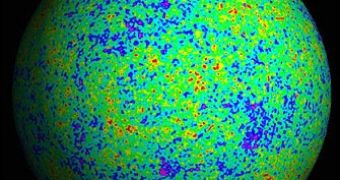Inflation theory predicts that, right after the Big Bang event, the universe went through a period of rapid expansion in space-time, which left behind a 'gravitational radiation' signature in the form of gravitational waves, distortions in the fabric of space-time, not yet proven to exist. However, a team of researchers from the Case Western Reserve University reckons that the same 'gravitational radiation' can be produced through a totally different mechanism.
"If we see a primordial gravitational wave background, we can no longer say for sure it is due to inflation," says Lawrence Krauss, Ambrose Swasey Professor of Physics and Astronomy at Case Western Reserve.
The inflation theory is absolutely required to explain why the universe so flat is and uniform, but also as a mean to understand what was the universe like in its early life, although most predictions are not closely correlated with observations. Gravitational radiation would be the single piece of evidence to confirm that indeed inflation theory is correct, and the universe suffered a sudden expansion in the outcome of Big Bang, 13.7 billion years ago.
In the early 1990s, Krauss proposed that gravitational radiation could be produced through different means than inflation, at the same time giving an approximation of the radiation spectrum. Recent calculations reveal that, in fact, the gravitational radiation signature would be much stronger than Krauss first estimated sixteen years ago.
"It is shocking and surprising when you dins the answer is 10,000 times bigger than the rough estimate and could possibly produce a signal that mimics the kind produced by inflation," argues Krauss.
According to Einstein's Theory of General Relativity, gravitational waves are produced when large masses of matter or energy move through space-time, thus disturbing the fabric of the universe. Such gravitational radiation would be undetectable on the large scale; however, recent experiments, like the Laser Interferometer Gravitational Wave Observatory, should directly detect it, if present. These efforts remain without result so far.
Another method that could be used to detect gravitational waves would involve measuring the effects on the cosmic microwave background radiation, signature left behind by the Big Bang. In the presence of a gravitational wave, the cosmic microwave background radiation would become polarized and could be easily detected with the help of the Planck experiment, scheduled for launch in 2009.
Nevertheless, Krauss' mechanism would also create CMB polarization. It involves a process called 'symmetry breaking', were 'scalar field' lines - a field similar to the electric and magnetic fields - would become aligned as the universe inflates. The contact between two scalar fields would render a different alignment, followed by a relaxation state were all field lines become aligned. During this particular process, the entire region of space would emit gravitational radiation.

 14 DAY TRIAL //
14 DAY TRIAL //